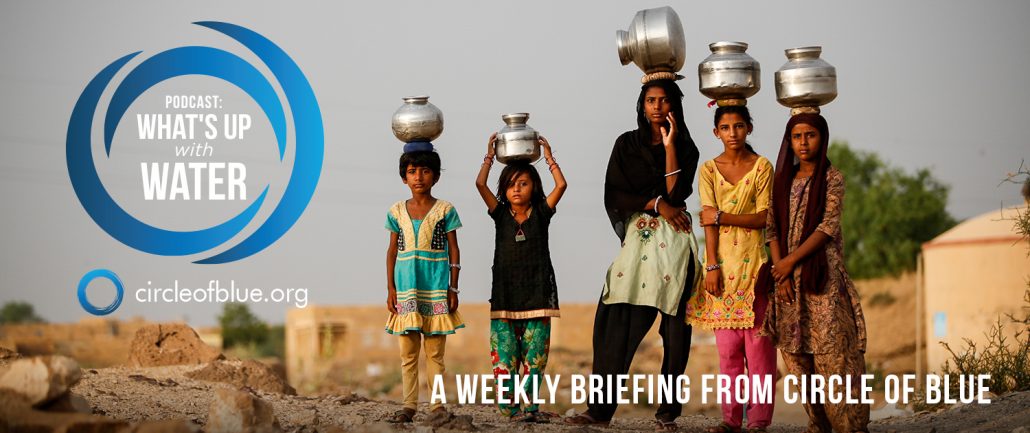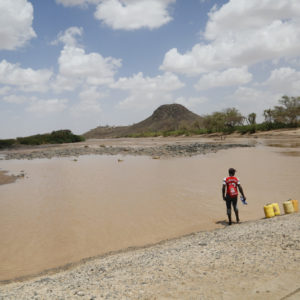
Transcripts
What’s Up With Water for May 21, 2018
NASA scientists warn that water shortages may well be the environmental challenge of the century. A new study, the first of its kind in scope and detail, used satellite observations and local monitoring to track trends in global freshwater between 2002 and 2016.
The scientists say we are witnessing “major hydrologic change,” with clear signs that the wet places on Earth are getting wetter, in high latitudes and the tropics, and the dry areas in the middle latitudes are getting drier. NASA identified over 30 areas where freshwater is especially vulnerable, due to the dramatic rates of groundwater depletion and melting ice.
These hotspots include areas in northern and eastern India, the Middle East, California, Australia, north-western China, Antarctica, Greenland, and the Caspian Sea. Some of these places have long been on the radar, while others have been undocumented until now.
Water-stressed areas share factors such as pollution and increased industrial and agricultural diversions of groundwater or rivers. Even when some locations receive normal rainfall, the water ecosystems fail to keep up with human demand. Increasing droughts magnify the problem.
Climate scientists have long predicted these global water patterns. The authors of the NASA report said it was premature to tie them definitively to global warming, but added that there was a “clear human fingerprint” on the planet’s water cycle.
A senior policy analyst at the charity WaterAid said that governments must heed NASA’s report and do more to provide freshwater to people in sustainable ways.
——————
Ethiopia, Egypt and Sudan say they have made headway in talks about Africa’s largest hydroelectric dam.
The Grand Ethiopian Renaissance Dam is a 5 billion dollar project on the Nile River. When complete, it will more than double Ethiopia’s current electricity production.
But Egypt, down the Nile from Ethiopia, worries that filling the dam could draw off too much river water, crippling Egypt’s agricultural base. Ethiopia says Egypt’s share of the Nile is not in danger and that the dam is important to development in Ethiopia, where 60 million citizens don’t have electricity. Egypt and Sudan are the foremost users of the Nile for irrigation and dams. Now that Ethiopia is building a major dam, it is emerging as a new player at the table and tensions have risen, threatening the political stability of the area.
Earlier talks on the subject failed, but this time officials in Egypt, Ethiopia and Sudan agreed to form a scientific group to advise them on best practices for filling the dam. Leaders from the three nations agreed to meet every six months for consultations and further negotiations are planned for early July in Cairo.
———————————-
In Turkey, plans for a shipping canal have raised fears of agricultural, archeological and environmental destruction.
The Kanal Istanbul will be 28 miles long and a quarter mile wide, connecting the seas to the north and south of Istanbul. It’s a 16 billion dollar project designed to reduce traffic and accidents on the Bosphorus strait, a major global shipping lane.
Turkey’s President,[ tie-YEEP ERR-doh-ahn] Tayyip Erdogan, touts the canal as another of his mega-projects, such as roads, trains, hospitals, and airports, saying it will fuel the economy. But critics call the proposal an environmental and urban disaster. A Turkish research firm estimates that 369 thousand residents could be affected by the canal, which would reconfigure one of Europe’s largest cities, destroy archeological sites and ruin a wildlife ecosystem. The canal will also destroy basins that supply nearly a third of Istanbul’s fresh water. A Turkish union of engineers and architects says this will raise the salinity of underground streams, with wide-reaching consequences for farmland. The canal will also lead to higher oxygen levels in the Black Sea, affecting the wildlife there.
Some in the shipping industry question the need for the new canal, suggesting that it would be more practical to improve the Bosphorus canal, which is seeing fewer, but larger ships. The proposed canal will cut through pastoral fields and about two dozen villages, where residents fear their livelihoods will be lost to process they are powerless to oppose. “Whether they want it or not,” said President [ERR-doh-ahn] Erdogan, “we will build Kanal Istanbul.”
—————————
In the United States, toxic algae is a growing problem in waterways across the nation, according to a report released last week. The non-profit advocacy organization called The Environmental Working Group used news coverage and satellite data to study toxic algal blooms. It found almost 300 blooms in rivers and lakes since 2010. They have occurred in nearly every state in the nation, and they are happening more often. In 2010, there were three algal blooms, and last year, 169 were reported.
These algal blooms are actually concentrations of a single-cell organism known as cyanobacteria. Blue-green or light green, they coat the surface water and can exude neurotoxins, liver toxins and skin irritants. Some of the toxins have been deadly to wildlife and pets, and have caused significant illness in humans.
The major cause of algal blooms is pollution from agricultural runoff, when phosphorous leaches into waterways. Other contributors include lawn fertilizer, phosphates from detergents, leaking septic systems and poorly treated wastewater. Additional factors include sunlight, low-wind conditions, warmer temperatures and invasive mussel species.
In 2014, Lake Erie suffered an algal bloom that made the water in Toledo unsafe to drink for several days. The United States Environmental Protection Agency responded with a health advisory about cyanobacteria in drinking water. It provided guidelines, but there are presently no legal limits for enforcement.
The EPA says that climate change has been identified as a contributing factor to algal blooms. It says that preventative measures are the preferred approach to managing the outbreaks, the most effective being the control of nutrient runoff. States like Ohio and Minnesota have enacted bans on certain fertilizing techniques such as spreading manure on frozen soil or requiring grass buffers at the edge of fields to intercept nutrients. But experts agree that more action is needed.
The first federal forecast for the Lake Erie algae indicated a range of possible outcomes this summer: from a mild bloom to a severe one. The bloom usually peaks in late August or September.
And that’s What’s Up With Water…We’d like to share what’s up where you are –
Tweet us with your water news: @circleofblue #whatsupwithwater.
Eileen Wray-McCann is a writer, director and narrator who co-founded Circle of Blue. During her 13 years at Interlochen Public Radio, a National Public Radio affiliate in Northern Michigan, Eileen produced and hosted regional and national programming. She’s won Telly Awards for her scriptwriting and documentary work, and her work with Circle of Blue follows many years of independent multimedia journalistic projects and a life-long love of the Great Lakes. She holds a BA and MA radio and television from the University of Detroit. Eileen is currently moonlighting as an audio archivist and enjoys traveling through time via sound.



